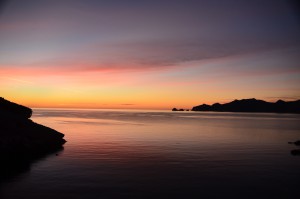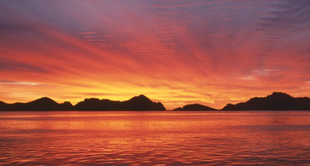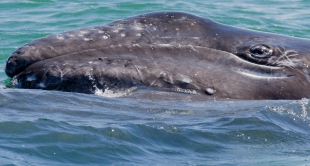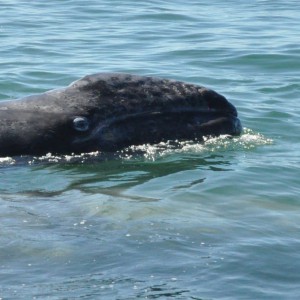 “It never rains in Southern Baja California” – we now know that that’s simply not true! At the beginning of our journey it was raining cats and dogs! Yet, already in the afternoon of the first days in the small oasis in the desert San Ignacio the sun was shining bright and the river invited us to swim, kayak and stand up paddle on it.
“It never rains in Southern Baja California” – we now know that that’s simply not true! At the beginning of our journey it was raining cats and dogs! Yet, already in the afternoon of the first days in the small oasis in the desert San Ignacio the sun was shining bright and the river invited us to swim, kayak and stand up paddle on it.
Our accommodation in San Ignacio was badly damaged by the hurricane “Odile” in September 2014. Keeping that in mind, it’s even more remarkable that such a big part has already been rebuilt. However, the unbelievable cozy yurts are now replaced by solid, round huts – and still very cozy. Usually the Baja California is no typical Hurricane region but observing the last centuries, about every 20 years one is passing by.
All our partners there have been affected in one way or another. Especially hard affected was Cabo San Lucas – the party zone of the Americans. The airport (forward-looking built, because there was a G8 summit several years ago here at the most southern point of Baja) was shut down for at least 3 weeks and there was no internet connection for a month. Furthermore, there have been many burglaries and raids shortly after the hurricane in Cabo and some other tragedies.
We didn’t observe any of this now, only that it is looking a bit messier (which frequently happens here either way ![]() ) than usual but overall we haven’t heard any complaints. People look ahead, sort things out and rebuild everything – often more pretty than before – and continue with their daily routine. Yet, the “high end-tourism” has not returned because the luxury resorts didn’t reopen until now.
) than usual but overall we haven’t heard any complaints. People look ahead, sort things out and rebuild everything – often more pretty than before – and continue with their daily routine. Yet, the “high end-tourism” has not returned because the luxury resorts didn’t reopen until now.
Astonishingly, the small wooden huts in our Gray whale camp in the lagoon of San Ignacio remained in sound condition – a tiny miracle!
As we arrived in the Gray whale camp on a Monday morning in February, the sun was shining bright and even before we could properly move into our huts, we found ourselves surrounded by Gray whales in the lagoon. What a celebration!
Already the first excursion was an absolute highlight! Gray whales everywhere, close to the boat and interactive… all expectations and imaginations exceeded, hearts touched and bathed by Gray whale blows we returned 2 hours later with amazing pictures.
Every tour is different and new. The best approach is to let all expectations behind on land and dedicate yourself to everything that is about to come and let yourself be surprised.
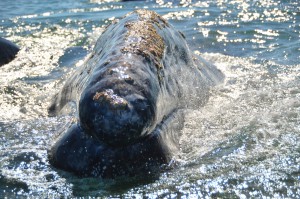 We stay in the Gray whale camp for 3 nights (yes, without Internet etc.) where you go to bed with the hens and get up when the sunrises. Where you get overwhelmed by the starry sky in the night and the Gray whales get you immediately under their spell. It is definitely addict potential to be surrounded by whales the whole time… and also dolphins are passing by as well as pelicans and many other birds of the lagoon. Sometimes one can see the Gray whales swimming further in the lagoon. Inside the lagoon of San Ignacio there is no boat traffic and the Gray whales find complete silence and calm there, if they like to. And then there are all those osprey nests, which are to be found quiet naturally in our neighborhood.
We stay in the Gray whale camp for 3 nights (yes, without Internet etc.) where you go to bed with the hens and get up when the sunrises. Where you get overwhelmed by the starry sky in the night and the Gray whales get you immediately under their spell. It is definitely addict potential to be surrounded by whales the whole time… and also dolphins are passing by as well as pelicans and many other birds of the lagoon. Sometimes one can see the Gray whales swimming further in the lagoon. Inside the lagoon of San Ignacio there is no boat traffic and the Gray whales find complete silence and calm there, if they like to. And then there are all those osprey nests, which are to be found quiet naturally in our neighborhood.
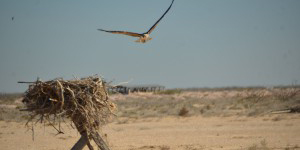 The most touching excursion was on the morning on day 3… a Gray whale calf was approaching the boat and emerging with its head the whole time while swimming alongside the vessel so that everyone in our group could caress it… literally touching – Moments apart from words. A shimmery pearl in our hearts.
The most touching excursion was on the morning on day 3… a Gray whale calf was approaching the boat and emerging with its head the whole time while swimming alongside the vessel so that everyone in our group could caress it… literally touching – Moments apart from words. A shimmery pearl in our hearts.
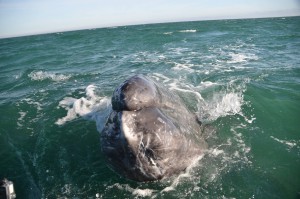 Is so good to know that with our visit in the San Ignacio lagoon we are really making a difference, because of our cooperation with our partner there, who is trying to offer his services without leaving a footprint. With our visit we strengthen the local community and to say it with the appropriate words of the Gray whale researcher Stephan Swartz: “Thank you for coming here. If there would be no interest in Gray whales they would have probably build a golf course, a marina or an industrial area.”
Is so good to know that with our visit in the San Ignacio lagoon we are really making a difference, because of our cooperation with our partner there, who is trying to offer his services without leaving a footprint. With our visit we strengthen the local community and to say it with the appropriate words of the Gray whale researcher Stephan Swartz: “Thank you for coming here. If there would be no interest in Gray whales they would have probably build a golf course, a marina or an industrial area.”
The San Ignacio lagoon is part of the Vizcaino biosphere reserve. It has a size of 25.468 km² and includes both coast lagoons Ojo de Liebre and San Ignacio. There are about 200 bird species living in that area, the beaches are home for the eggs of 4 endangered water turtle species like the hawksbill turtle, green turtle and the Ridley sea turtle. The water of the lagoons presents a spot of collection for the Gray whales that come here after their long journeys from the arctic waters of the Bering Sea and the Chukchi Sea, to give birth to their calves and for mating. 300 prehistoric petroglyphs have been found on the mainland.
The arid environment of the reservation is home for Pronghorn antelopes, Bighorn sheep, cougars and bobcats. Already in 1993 the biosphere reservation with its protectorate has been declared to UNESCO world natural heritage.
And then? Caught in the next paradise! After 3 intensive Gray whale days it makes sense to “recover” in a marvelous bay. This bay in the Sea of Cortez is a shimmery pearl itself. Kayaking, swimming, snorkeling, relaxing and the joy of the far view and the Mexican food = a good combination and of course as well to be on a par with pelicans for example while being on the Stand up paddle or in the kayak. 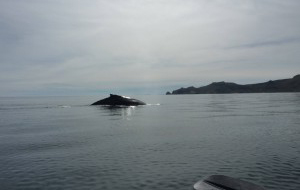 Daily, big whales (presumably a Blue whale and a Finback whale mother with her calf) came into the bay. From afar we could observe them circling and eating in the bay. But not only from afar but one time, quite close (5-10m) to our Kayak, a Humpback whale emerged with a loud blow. Wow, he really wanted to know it… Stunning breath taking moments. Shimmering pearls…
Daily, big whales (presumably a Blue whale and a Finback whale mother with her calf) came into the bay. From afar we could observe them circling and eating in the bay. But not only from afar but one time, quite close (5-10m) to our Kayak, a Humpback whale emerged with a loud blow. Wow, he really wanted to know it… Stunning breath taking moments. Shimmering pearls…
At the beach are 5 petroglyphs of the original inhabitants of the Baja California to be found. Significantly one can imagine a whale with its calf… or is our sight blurred because of our “cetacean glasses”?
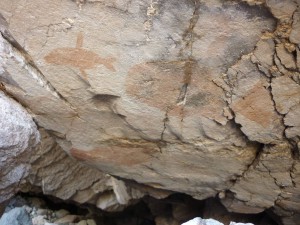 Calm, sparkling ocean… for hours the ocean is completely calm, looking like it is covered with a silky scarf. This is also a part of the beauty of the Sea of Cortez: repeatedly super calm moments on the ocean and the sunrises and –sets. An incomparable lightshow in the sky: shimmery pearls.
Calm, sparkling ocean… for hours the ocean is completely calm, looking like it is covered with a silky scarf. This is also a part of the beauty of the Sea of Cortez: repeatedly super calm moments on the ocean and the sunrises and –sets. An incomparable lightshow in the sky: shimmery pearls.
Then we are heading further to Loreto – on the tracks of the Blue whales.
When traveling with angles, you will have good fortune with the weather. The ocean was calm when we started our tour at 7 a.m. to find the Blue whales. This time, the whales were coming far up in the Sea of Cortez so that it only took us only about 15 minutes until we could marvel at the first gigantic blow (about 8 m high). We were actually expecting a 1-2h drive. How lucky!
We stayed close to a Blue whale and observed his behavior, his diving rhythm and whether he was a “Fluker” or not? Only 20-30% of the Blue whales show their fluke while descending – Fins in contrast never. So we spend our morning surrounded by several Blue whales… – we saw 5-7 animals on our tour and in the late forenoon there was also a “Fluker” amongst them.
Blue whales play in their own league. Only Fin whales – with whom there are also sometimes some “very close” moments – can keep up with them. Several cases of hybrid births between Blue and Fins whales are known. The big animals of this planet behave very differently than the Gray whales. They are really rarely looking for contact to the boats and have much longer diving periods.
The species is still endangered with an estimated population of about 5000 animals worldwide. For them the noise pollution of the oceans is very hard to cope with, because the communication over very long distances is essential for their survival, and they have to struggle with the industrial use of krill for human purposes. No krill, no Blue whales.
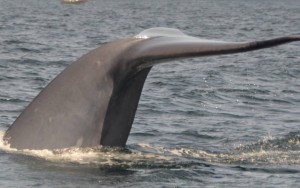 Around noon we make a detour to a close by sea lion colony (Californian sea lion). Those “lazy” land-animals only move when really necessary and just slip into the water for eating.
Around noon we make a detour to a close by sea lion colony (Californian sea lion). Those “lazy” land-animals only move when really necessary and just slip into the water for eating.
Afterwards we again passed by one or another Blue whale – the biggest animal that has ever lived on this planet. Our captain tells us that there has been an animal with a length of 37 m. Normal Blue whales have a size of about 30 m. Shortly before we heading back the harbor again – out of the Blue – a huge Blue whale passed by relatively close to our small boat. This gave us once again the opportunity to marvel at the full size and dimension of this species.
Lots of luck and another pearl for our collection! The next day was very, very windy. However, that didn’t keep our scuba divers and snorkelers from the one or other dive… the drive back was quite adventurous. Ocean water salted, one is looking forward to a hot shower afterwards.
After a travel day through the desert like landscapes with volcanic origins, which are much greener this year because of the increased amount of rain, we arrived in La Paz.
On the next day there, we made an excursion to encounter the biggest fish on this planet. At the beginning too many boats were occupied with only 1-2 whales. We didn’t like that. We like to do it a respectful manner and were happy as our captain moved on to find another animal. We kept driving and found our “own” Whale sharks and some members of our group swam about 1 hour with an animal of a length of about 6-7 meters. Further Whale sharks passed… they look beautiful. Timeless moments! Shimmering pearls…
Only since a couple of years, Whale shark pups spend their time in the bay of La Paz Whale – the children and teens so to say – which is why they are relatively “small”. Fully grown they reach a size of about 15 meters. The baby Whale sharks eclose from the eggs already in the womb and are then left to their own. They become sexually mature at the age of 30 and can get 100 years old. They feed on plankton and because of that they are coming to the bay of La Paz. From January on, when the water starts getting green, the water is nutrient rich and full of plankton.
A pearl and an absolute highlight – the encounter with these animals. There is no other place in the world with similarly perfect swimming conditions with Whale shark pups.
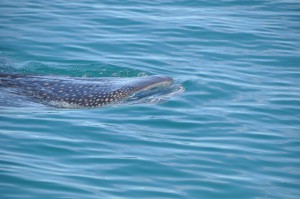 Further our travel went – passing by the lovely places Todos Santos at the Pacific coast to the party region of the Baja: Cabo San Lucas. Home of the money and surely “washed” the one or other time. In the harbor one can see yachts where only the tank contents cost 25.000 USD. However, we are here because of the Humpback whales!
Further our travel went – passing by the lovely places Todos Santos at the Pacific coast to the party region of the Baja: Cabo San Lucas. Home of the money and surely “washed” the one or other time. In the harbor one can see yachts where only the tank contents cost 25.000 USD. However, we are here because of the Humpback whales!
The Gray whales didn’t go all the far way down to the southern end “Lands’ end” this year ( it is El Nino year and the water is warmer than normal)!
On the next day we went out on the ocean and after we visited all of the throughout nice touristic spots like “Lands’ end”, lovers beach and the famous Arch of Cabo, we already saw a small Humpback whale jumping, again and again.
Of course all boats were heading this direction… too many in my opinion! At least they were keeping a respectful distance and the calf didn’t seem to mind – he or she simply had fun and jumped and jumped! And then suddenly also the 40t mother came out of the water… that was Mum, wow! After we enjoyed the show for a while we drove further to seek and, very soon, to find other whales! A very small calve enjoyed the moment and practiced “breaching”. No other boats around…
Later on that tour we also saw two big animals jumping simultaneously in the distance. Breath taking!
A further shimmering pearl…
We were heading towards this direction and recognized a whale pair of a mother with her calf, accompanied by another mature animal… male or female? A male that was trying his luck even though the mother was still lactating? Another female? Recent scientific publications reveal that also Humpback whale mothers are looking for the company of other females at and after giving birth – like nearly all other cetaceans too.
From time to time they jumped and also the calf practiced the “Head bang” etc. Again we had lots of luck!
Nobody, including me, had expected such a highlight tour. It was relatively sure that we would see some Humpback whales but that they pamper us in this way with their different behaviors and numerous jumps… a further shimmering pearl as farewell, because on the next day, we all returned to Europe. Thank you – beautiful Baja. We will return.



